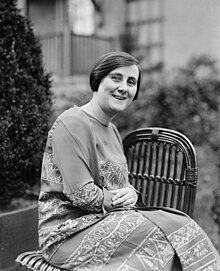Bertha Lutz: Difference between revisions
→External links: rm parent cat |
m Added the {{Authority control}} template with VIAF number 8632020. |
||
| Line 32: | Line 32: | ||
}} |
}} |
||
{{DEFAULTSORT:Lutz, Berta Maria Julia}} |
{{DEFAULTSORT:Lutz, Berta Maria Julia}} |
||
| ⚫ | |||
| ⚫ | |||
{{Authority control|VIAF=8632020}} |
|||
[[Category:1894 births]] |
[[Category:1894 births]] |
||
[[Category:1976 deaths]] |
[[Category:1976 deaths]] |
||
| Line 43: | Line 48: | ||
[[Category:Feminist writers]] |
[[Category:Feminist writers]] |
||
[[Category:People associated with Federal University of Rio de Janeiro]] |
[[Category:People associated with Federal University of Rio de Janeiro]] |
||
| ⚫ | |||
| ⚫ | |||
[[es:Berta Lutz]] |
[[es:Berta Lutz]] |
||
Revision as of 18:02, 4 October 2012

Berta Maria Júlia Lutz (August 2, 1894, São Paulo – September 16, 1976, Rio de Janeiro) was a zoologist, and scientist who became a leading figure of the feminist movement in Brazil.
She was born in São Paulo. Her father, Adolfo Lutz (1855–1940), was a famous physician and epidemiologist of Swiss origin, and her mother, Amy Fowler, was a British nurse. Berta Lutz studied natural sciences, biology and zoology at the University of Paris - Sorbonne. After returning to Brazil, she dedicated herself to the study of amphibians, especially poison dart frogs and frogs of the family Hylidae.[1] The Lutz's Rapids Frog (Paratelmatobius lutzii, Lutz and Carvalho, 1958), was described by her. In 1919, she was hired by the Museu Nacional do Rio de Janeiro, a fact which achieved great repercussion in the country, because the access to public offices was barred to women at that time. She later became a naturalist at the Section of Botany at the same institution.
In 1918, Berta returned to Brazil and spoke out for a feminist movement to begin. After seeing the advancements made by European and American women towards the feminist movements, she could see that Brazilian women could also help out with the movement by lending whatever aid they could to the organization. In 1922, Berta attended the Pan American Conference of Women, and was advised by Paulina Luisi and Carrie Chapman Catt. Following the conference, Berta drew up the constitution for a group named the Federação Brasileira pelo Progresso Feminino (FPBF) [English: Brazilian Federation for the Advancement of Women].
In 1934, the women of Brazil earned the right to vote due to Lutz and her organization.
As a politician, Berta Lutz was elected a deputy federal representative in 1934, after failing two successive ballots. Her main political platform was changing worker's legislation in relation to women's right to work, child labor, gender equality in wages and rights, the lawful right to maternity leave. She lost her mandate when Getúlio Vargas closed down both legislative chambers in 1937.
Lutz was one of four women who signed the United Nations Charter at San Francisco on 25 Oct. 1945 ≤UN Charter; UN Chronicle 2002≥. She was also Brazil's representative to sign the important treaty on Diplomatic Asylum 1954. ≤UN Treaty Series≥
- ^ Lutz, Bertha. Brazilian species of Hyla. 1973. University of Texas Press. Austin.
See also
External links
- Bertha Lutz: Photographs from LIFE Magazine, three black-and-white photos, captioned in English
- Berta Lutz: Biografia. Getúlio Vargas Foundation CPDOC (In Portuguese)
- Berta Lutz: Biografia. Mundo Físico (In Portuguese)
- Brazilian scientist stubs
- Women's rights activist stubs
- 1894 births
- 1976 deaths
- University of Paris alumni
- Brazilian feminists
- Brazilian zoologists
- Brazilian herpetologists
- Brazilian people of Swiss descent
- Brazilian people of English descent
- Women biologists
- Feminist writers
- People associated with Federal University of Rio de Janeiro
